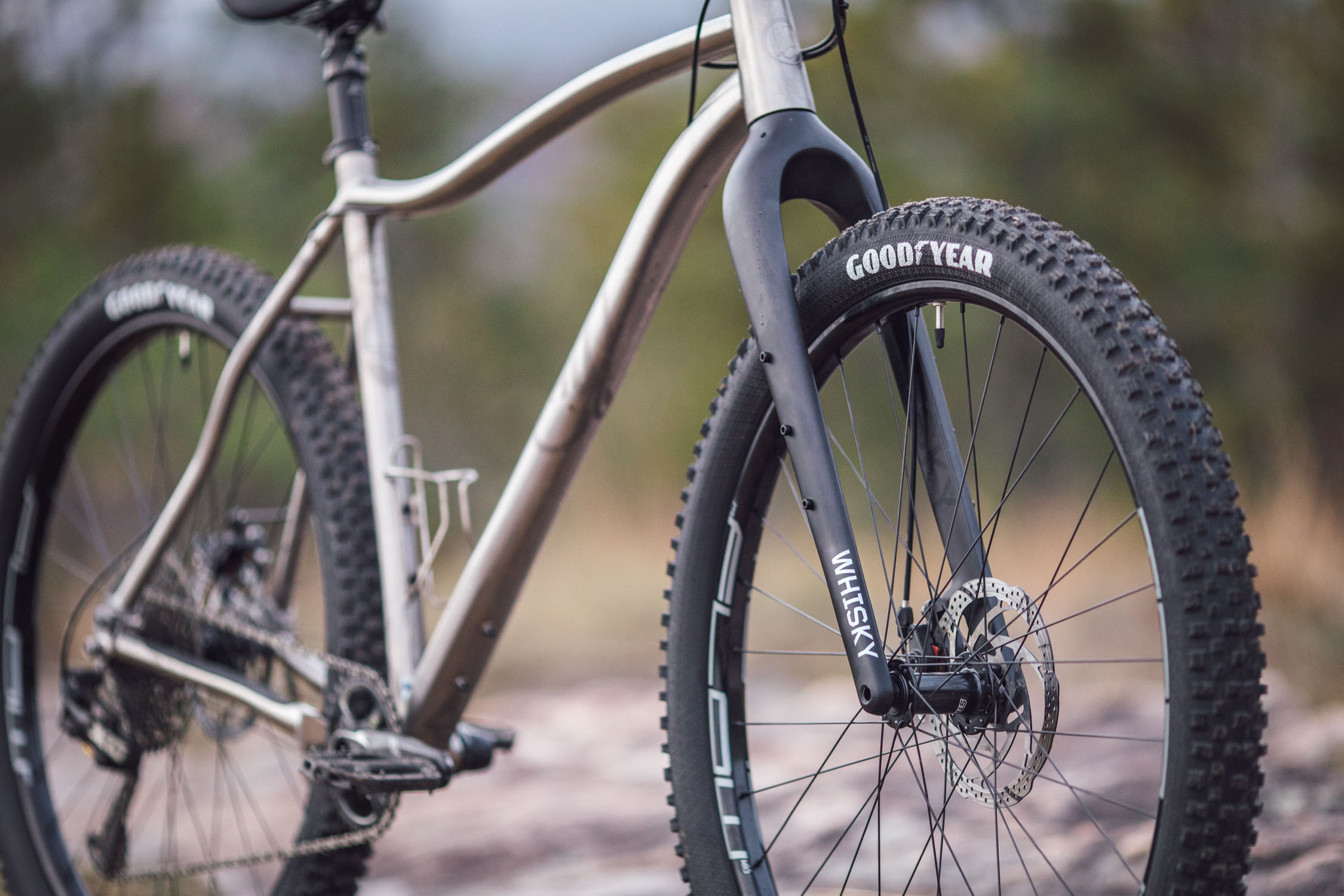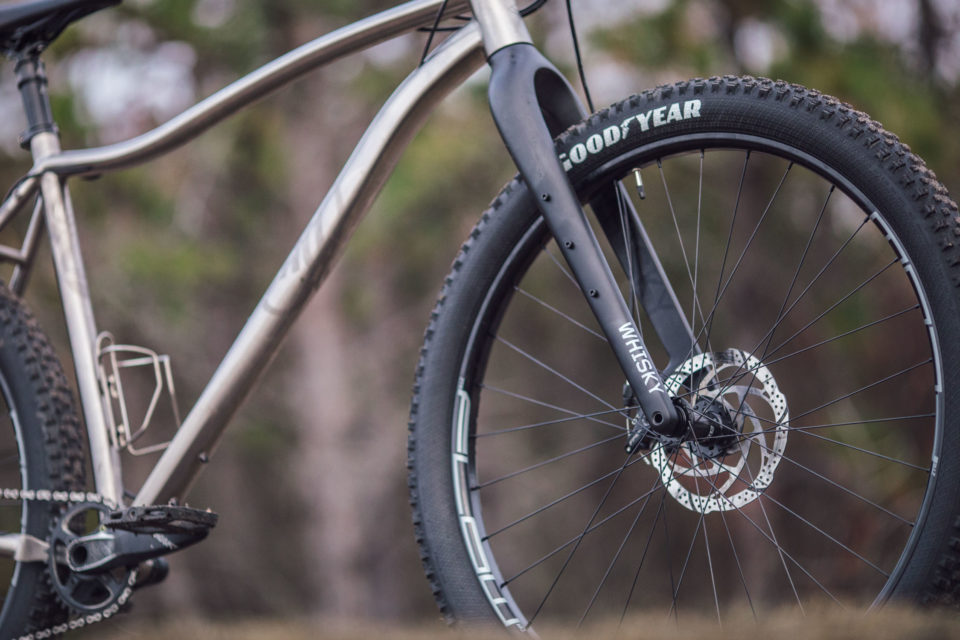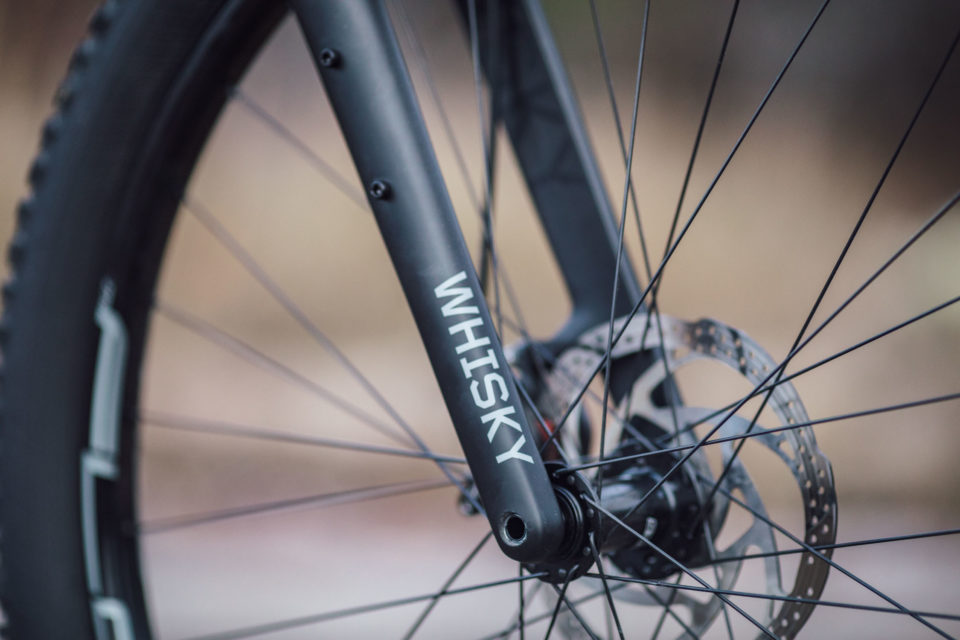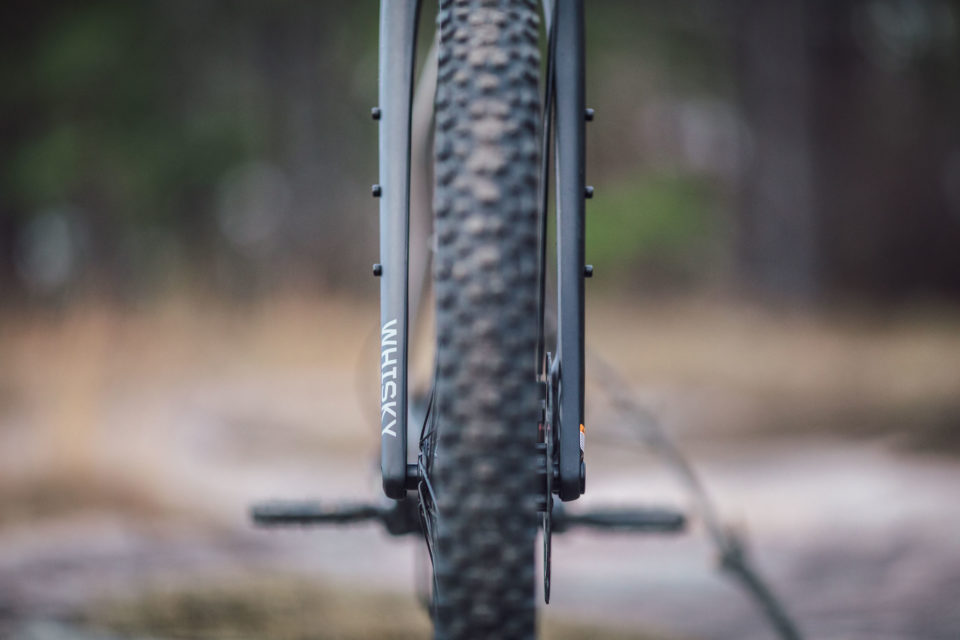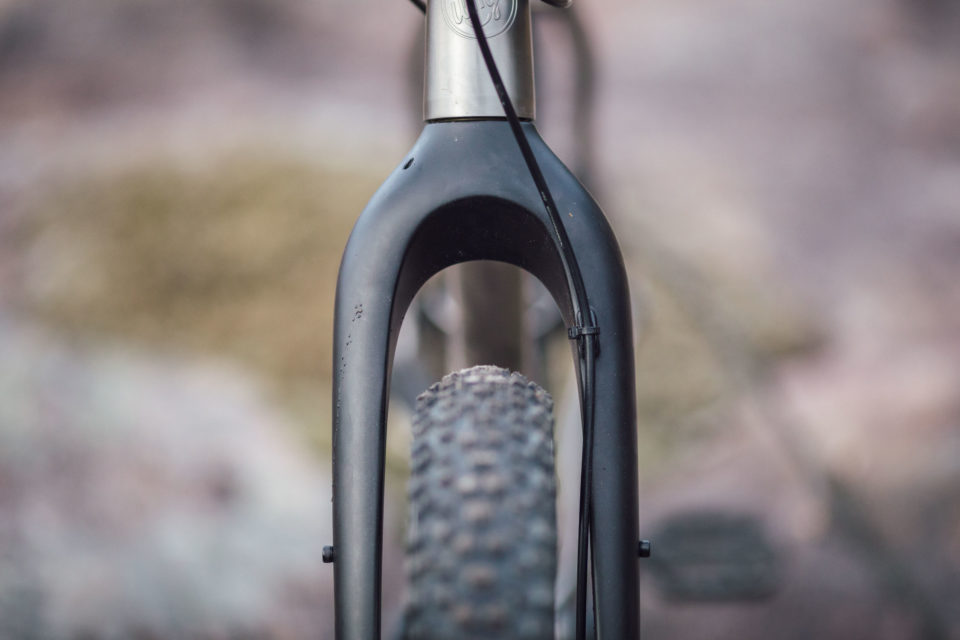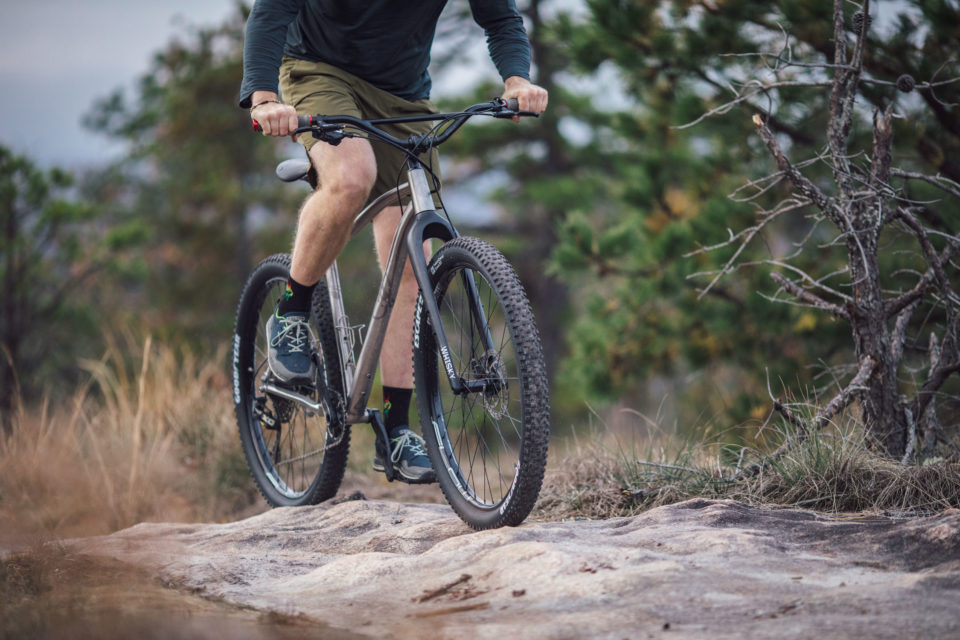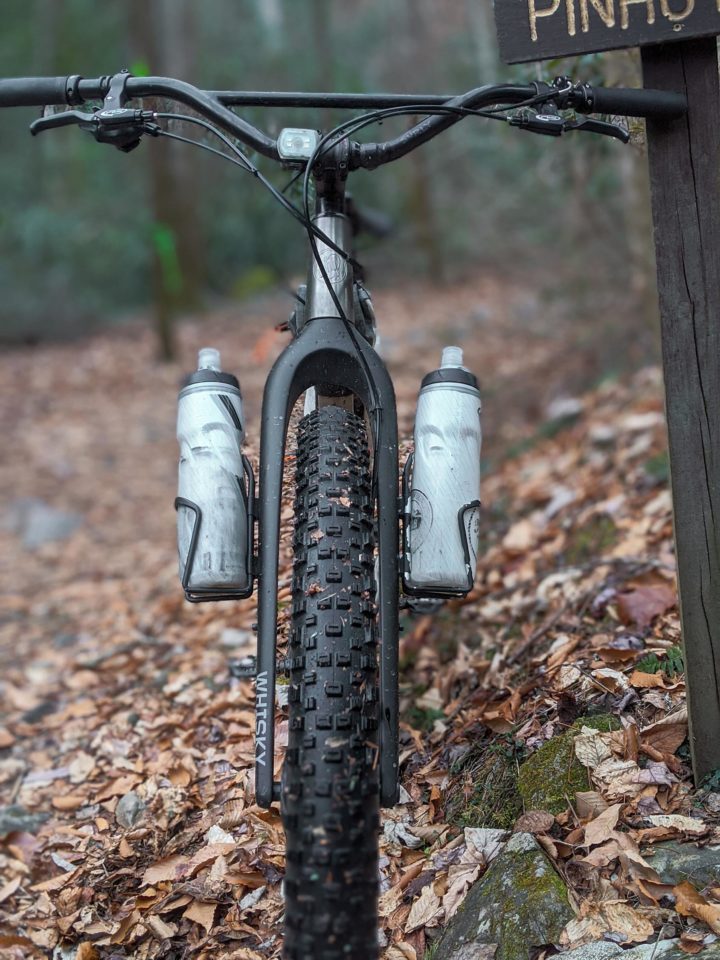New Whisky Carbon Boost Fork Review (Whisky No.9 MTN LT)
Share This
Whisky Parts just released a Boost MTB fork (the Whisky No.9 MTN Boost LT Fork) designed for modern trail/bikepacking bikes with 120-130mm front suspension. No.9 features three-mount cargo cage mounts and loads of tire clearance. We had the chance to test one prior to launch. Here’s our detailed review, all the specs, and photos…
The Whisky No.9 MTN Boost LT is the latest “utility fork” to hit the streets. It was designed as a suspension fork replacement to transform modern trail bikes into distance machines for gravel roads and bikepacking routes. It features a full unidirectional carbon construction paired with a tapered steerer tube, thru-axle dropouts, two three-pack mounts, and a 500mm axle to crown length. Here’s the full review.
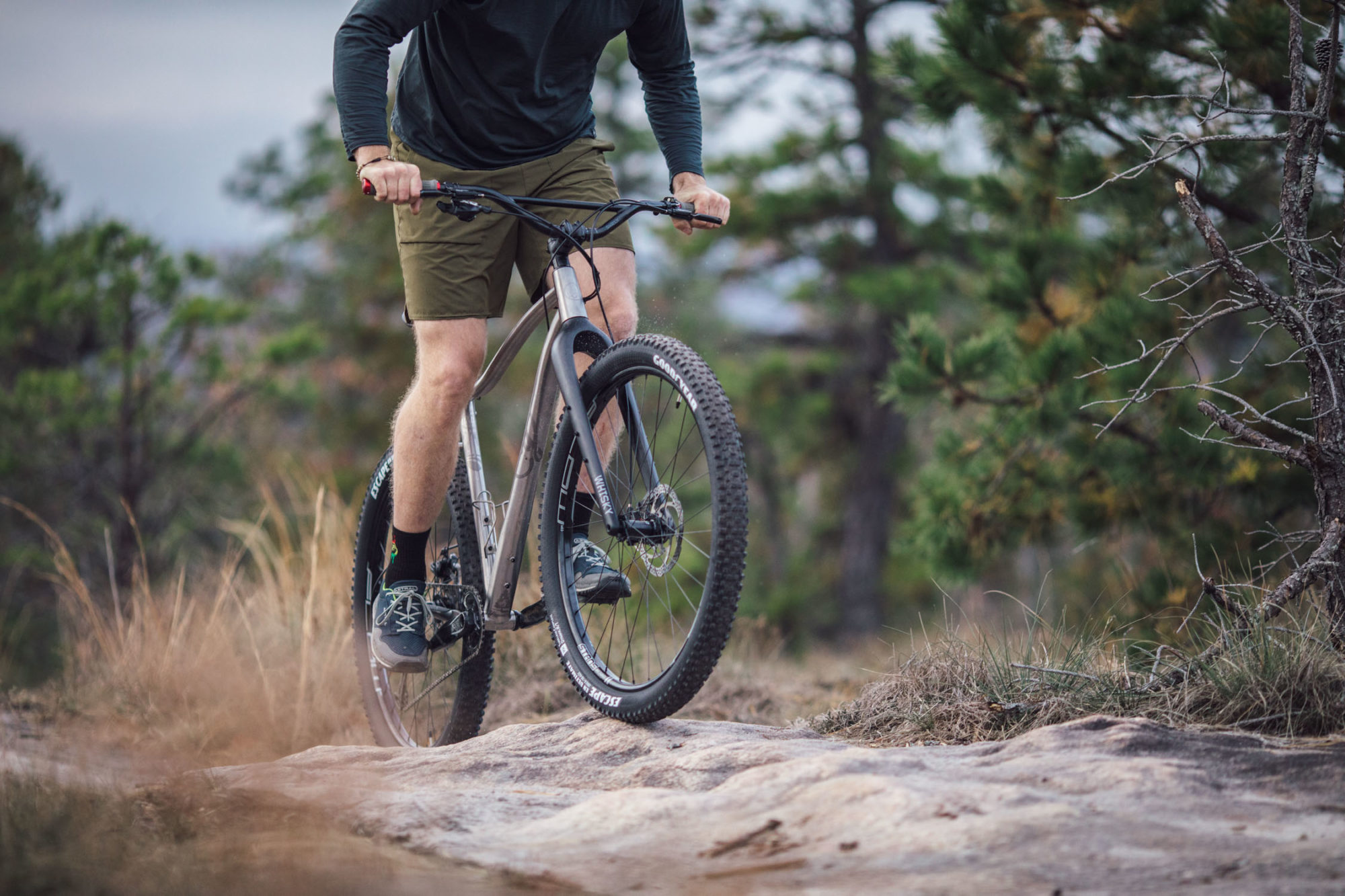
Based out of Bloomington, Minnesota, Whisky Parts Co. specializes in designing carbon bicycle parts. Their products range from carbon rims and forks to stems, bars, and bottle cages for mountain, road, gravel, and cyclocross bikes. Whisky is owned by mega distributor Quality Bicycle Components (QBP), that has a ton of other brands under its roof, including Surly, Salsa, All City, 45North, and Teravail. Like most QBP brands, Whisky was founded by employees who asked “Why isn’t someone making X?”… and boom, in 2011 Whisky Parts Co was born.
Carbon forks have been around for a long time, and for good reason. With a weight that’s far lighter than steel, tapered steerer tubes to increase stiffness and responsiveness, and unique vibration damping characteristics, they have all the ingredients to make long days a little easier on the upper body. But can’t you just run a suspension fork to get many of those characteristics (as well as a little cushion on rowdy terrain)? Sure. But that comes at the price of weight, pedaling efficiency, and reliability. Factor in the cost of modern suspension forks and their yearly maintenance fees and the humble rigid fork looks that much more appealing.
Whisky has had a No.9 carbon mountain fork in their lineup for some time now. However, the older model was designed with a 483mm axle to crown (A-C), or about the same A-C as a 100mm suspension fork sagged 20 percent. The updated version is aimed at 120-130mm travel bikes with an axle to crown of 500mm and Boost spacing. It’s important to remember that those numbers are based on a suspension fork sagged 20%, so if you took a 120mm Rockshox Pike that has a static (unsagged) A-C height of 531mm, then multiply 120mm by 25% (30mm), then subtract that from the 531mm A-C, you get 501mm. I use 25% over 20% because most people on trail bikes sag in 25%. Logan went pretty in-depth about these numbers when he reviewed the Niner RDO carbon fork last year.
Here are the full specs of the No.9:
- Axle to Crown/Fork Length: 500mm, for use bikes designed around 120mm to 130mm suspension forks
- Rake: 51mm
- Axle Type: Boost 110mm x 15mm
- Tire Clearance: 29 x 3.0″ or 27.5 x 3.0″ tires
- Dynamo Routing: Full internal routing for light cable
- Mounts: Two sets of Three-Pack mounts, no fender mounts
- Included Parts: Whisky No.9 Thru Bolt and compression plug
- Max Rotor: 180mm
- Brake Type: Post Mount Disc Brake
- Steerer: 1 1/2″ Tapered, 280mm
- Material: Raw UD Carbon
- Crown Race: 40mm
- Weight: 680g (uncut), 645g as tested/cut
- Part Number: FK7903
- Max Rider Weight: 240 lbs
Even after working as a mechanic for nine years, I’m still caught off guard by how light carbon forks are every time I handle one. The Whisky No.9 MTN Fork is no exception. I’ll admit that I forgot to weigh it before I cut the steerer tube, but I run an XL frame and always leave 40mm of stack height to play with. This typically leaves my steerer tubes long enough to the point where they usually max out the manufacturers recommended allowance for spacers. Once it was cut ever so slightly, the No.9 weighed in at 645g, which is very light.
Installing was a straightforward and standard affair. One note is that I’ve started putting a little carbon paste on the inside of the steerer tube where the compression plug sits to help thwart any upward movement when loosening the headset preload. I have struggled to keep my headset from loosening up on my Fargo, especially when riding the harder, rockier trails in Pisgah. So far, I haven’t had a single issue with the Whisky fork compression plug moving.
I mounted the No.9 up on my trusty Why Cycles Wayward, a bike I built specifically with low maintenance, reliability, and comfort in mind, as this is going to be the bike I bring along for the 2020 Tour Divide. The Wayward is already a super comfy bike. It’s like riding a couch, especially when loaded down. I knew I wanted to run a rigid fork, but swapping the Firestarter off of my Fargo didn’t seem like a great idea; the Wayward already has a relatively low bottom bracket and the drop in A-C with the 483mm Firstarter would make it even lower. The No.9 also complements my Wayward’s fully mechanical build. I didn’t want to have to worry about bleeding any hydraulics or making sure a suspension fork wasn’t going to fail. Modern bike hydraulics have a good reputation but shit happens out on long routes and a rigid fork with big squishy tires won my vote.
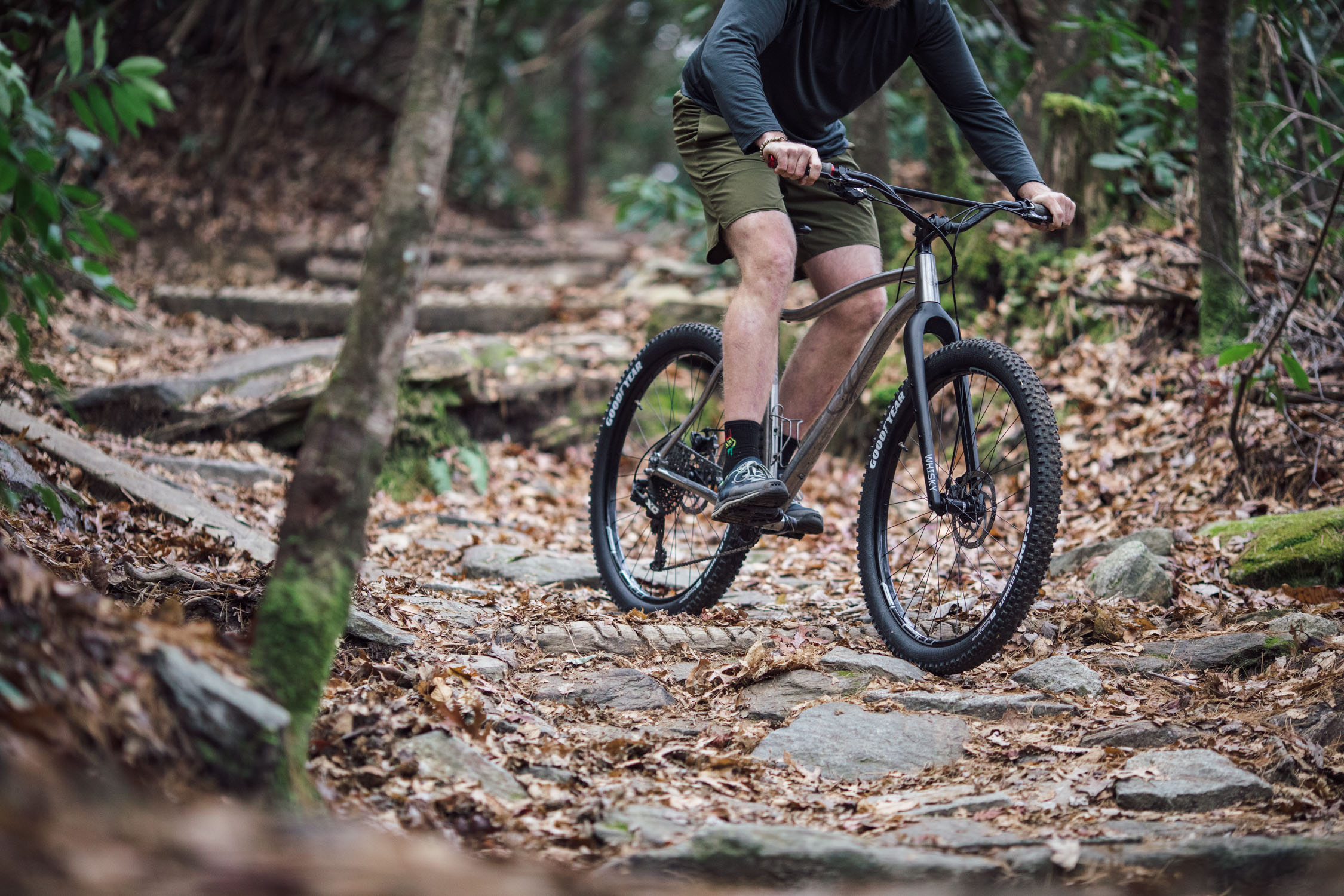
On the Trail
Once mounted up, I immediately rolled out into the woods. Climbing with a rigid fork will make you feel like you ate two extra bowls of Wheaties that morning. All the power you are putting down goes directly into the ground. And the missing 2.72 pounds—after replacing a RockShock Pike—will make you feel like a rocket up the hills. The reduced weight in the front of the bike also makes the steering a bit more responsive and makes it easier to lift the front wheel up and over features on the trail.
Cornering with a rigid fork, especially loaded, can create a lot of stress. The lateral/twisting movement in some forks can be downright unnerving in certain situations. When riding slower, more technical corners, such as a rocky switchbacks, I have had some steel and suspension forks twist up to the point where I had to fight the front wheel to turn. The sensation of trying to turn the bars and feeling the fork twist because the tire doesn’t want to move is unsettling. Luckily, this wasn’t the case with the No.9, which is incredibly stiff laterally, translating to great tracking on the trail whether you’re going straight or railing in the corners.
If there is one area that suspension forks best rigid forks, it’s descending. Then again, you don’t run a rigid fork beat your local Strava records down the mountain, although I have seen my friend and Jamis Factory rider Thomas Turner crush some folks at the Pisgah Enduro on a rigid single speed (in a skin suit), but that’s neither here nor there. My first proper descent on the No. 9 was down the steep side of Cedar Rock and a run down Burnt Mountain in Dupont State Forest here in western North Carolina. I was a little nervous running mechanical brakes and a rigid fork on such steep and rocky/rooty trails, but the No.9 got me down without a fight. And it tracked well over all the small drops and big roots. Yes, you do feel like a pogo stick at times riding rigid, but that’s a sacrifice I’m willing to make for such a light, compliant, and efficient fork.
Crushing gravel miles on this fork is a dream. All of the small bumps and vibrations that gravel and dirt roads dish out can take their toll on your hands and shoulders during long rides, causing upper body fatigue and possibly even long-term issues. Given its vibration dampening characteristics, carbon does wonders to minimize these effects and keep the small bumps and vibrations in check. But not all carbon forks have equal vibration dampening benefits, so having a nice chunk of carbon to sort out those vibrations will help you out in the long run. Comparing the No.9 to Salsa’s Firestarter, which I have thousands of miles on, I would say the two forks are quite similar, and that’s a good thing. Over the years, the Firestarter has proven itself as a reliable, comfortable fork. The No.9’s 17mm taller A-C is a huge plus for those looking for a rigid fork for a modern hardtail without changing the bike’s original geometry. It’s also worth noting that the No.9 is 10mm longer than the popular Niner RDO.
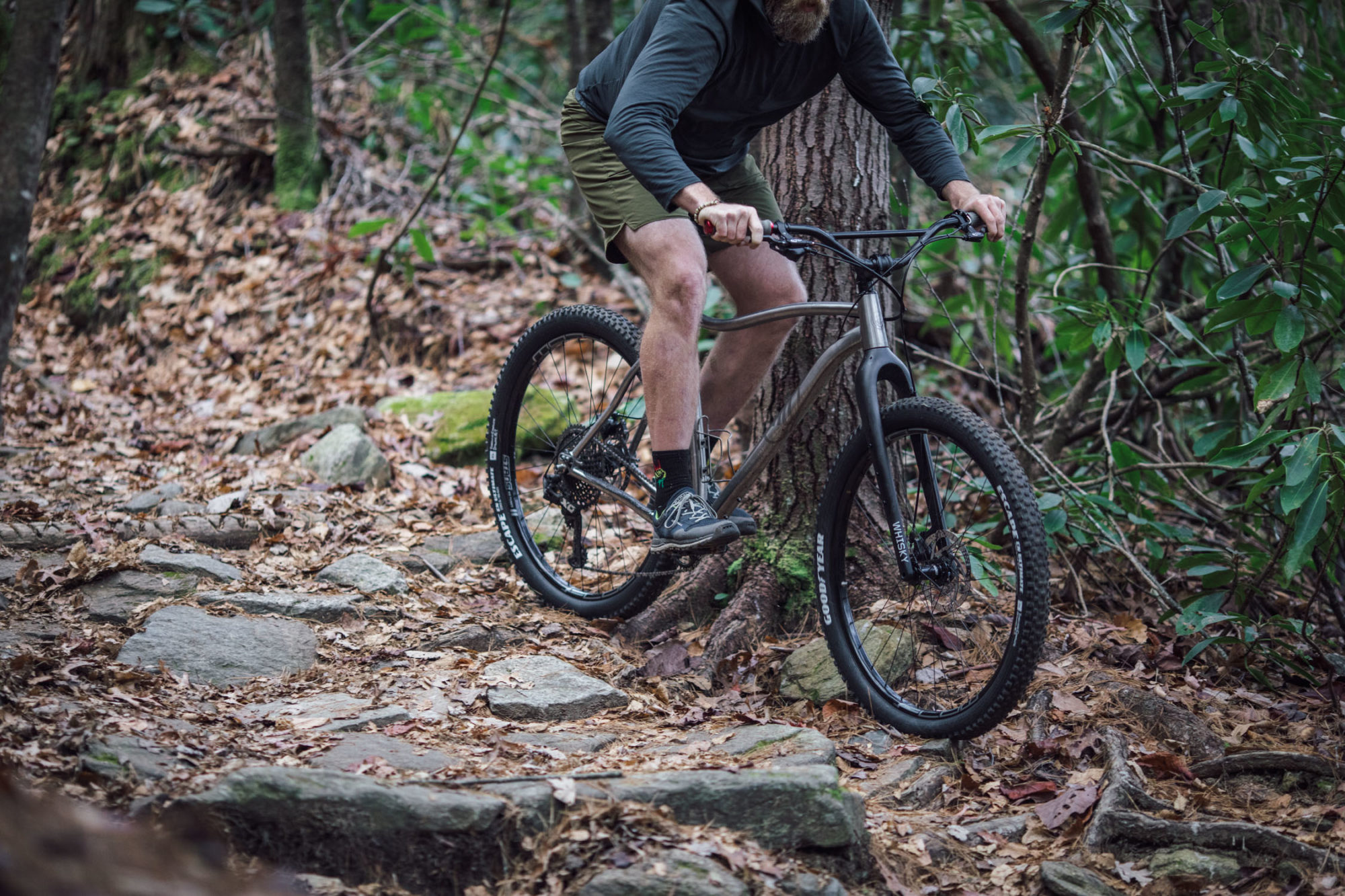
The Whisky No.9 comes with one set of three-pack bosses on each side of the fork to mount your cages of choice. I prefer to run my water bottles in that position when I’m on tour, but you can mount your favorite Anything-style cargo cage and haul all of the snacks, stoves, whiskey, or camping gear that you please. The bosses are placed in a centered position along the outside of the fork. I don’t have a strong opinion on that placement, but feel it works well and is slightly easier to reach than the cages mounted on my older Firestarter, which has them angled toward the front. I know some folks might prefer two sets of bosses front and rear, but how much stuff do you really need to haul?
Despite the three-pack bosses, I was surprised that the No.9 doesn’t have fender or dynamo light mounts. In my opinion, if you’re going to have internal dynamo routing on the fork, you might as well have a mount for the light, too. Not everyone runs their dynamo light on the bars. Whiskey had this to say about the lack of light mount on the fork, “In our experience, a handlebar- or helmet-mounted light is more secure and effective for illuminating the trail than a crown-mounted light, especially for off-road use. Lights mounted at the fork crown are also easily obstructed by handlebar bags and other bikepacking gear that might hang in front of your bike.”
Fender mounts are more of a personal preference, but for some riders, a fork that’s touted as a utility fork should be able to run a full fender.
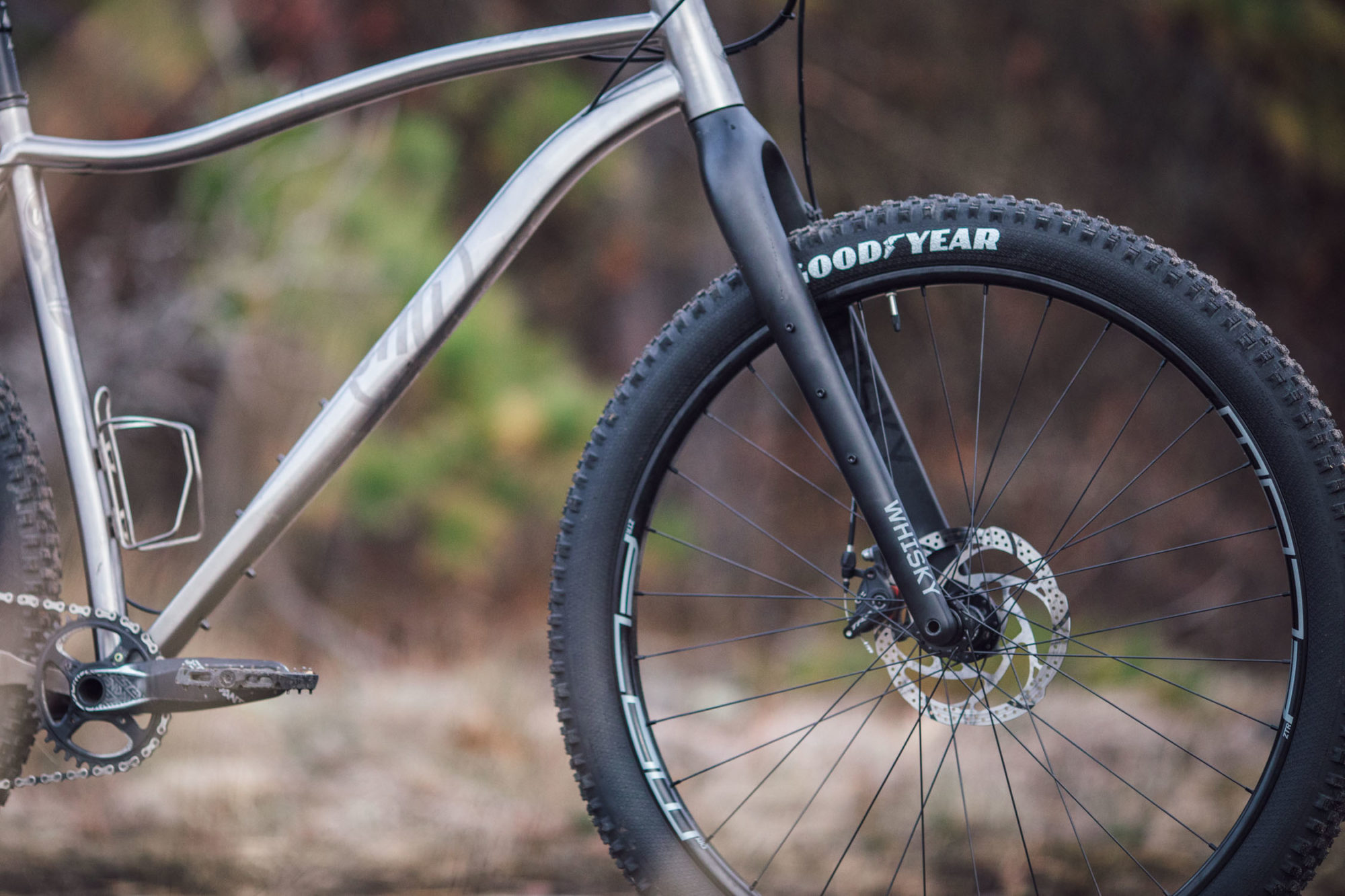
Pros
- Lightweight and stiff
- Tracks very well in rough terrain
- Internal dynamo routing
- Two sets of three-pack bosses (snacks!)
- Trail-bike-friendly Axle-to-Crown ratio
- Reliable and maintenance free
- Clearance for up to 29 x 3.0 or 27.5 x 3.0 Tires
Cons
- No fender or light mounts
- Comparatively rough on rowdy descents
- Recommended max rider weight 240lbs
- Weight (cut steerer) 645 grams
- Place of Manufacture China
- Price $549.99
- Manufacturer’s Details WhiskyParts.com
Wrap Up
Overall, I’m very impressed with the Whisky No.9 carbon fork. It’s light, efficient, and reliable. It can haul snacks, water, or gear on its three-pack bosses and even has internal routing to protect the wires on that fancy dynamo light you splurged on.
Is this the fork I’d choose for a tour of the Colorado Trail or the AZT? No. Those trails are rough and rowdy, and while the No.9 will get you through, the advantages offered by a carbon fork diminish quickly when traversing and descending on that much chunky terrain. That said, I’ve ridden it on some pretty rowdy terrain and never once felt like it was too weak or flimsy. If I was riding a route like the Tour Divide, TNGA, or Cohutta Cat—trails that require a ton of climbing and have a little technical singletrack—this would definitely be my first choice over a suspension fork.
I can see this fork being the perfect solution for someone who has a bike like the Santa Cruz Chameleon and wants to get into ultra-distance bikepacking without spending money on another bike. With a simple fork change, you could go from trail bike to multi-month bikepacking rig while preserving the bike’s original geometry and using all that money you saved for more snacks!
The new Whiskey No.9 Boost LT MTN Fork retails for $549.99 USD and can be ordered now through your local Whiskey Parts dealer.
Please keep the conversation civil, constructive, and inclusive, or your comment will be removed.






